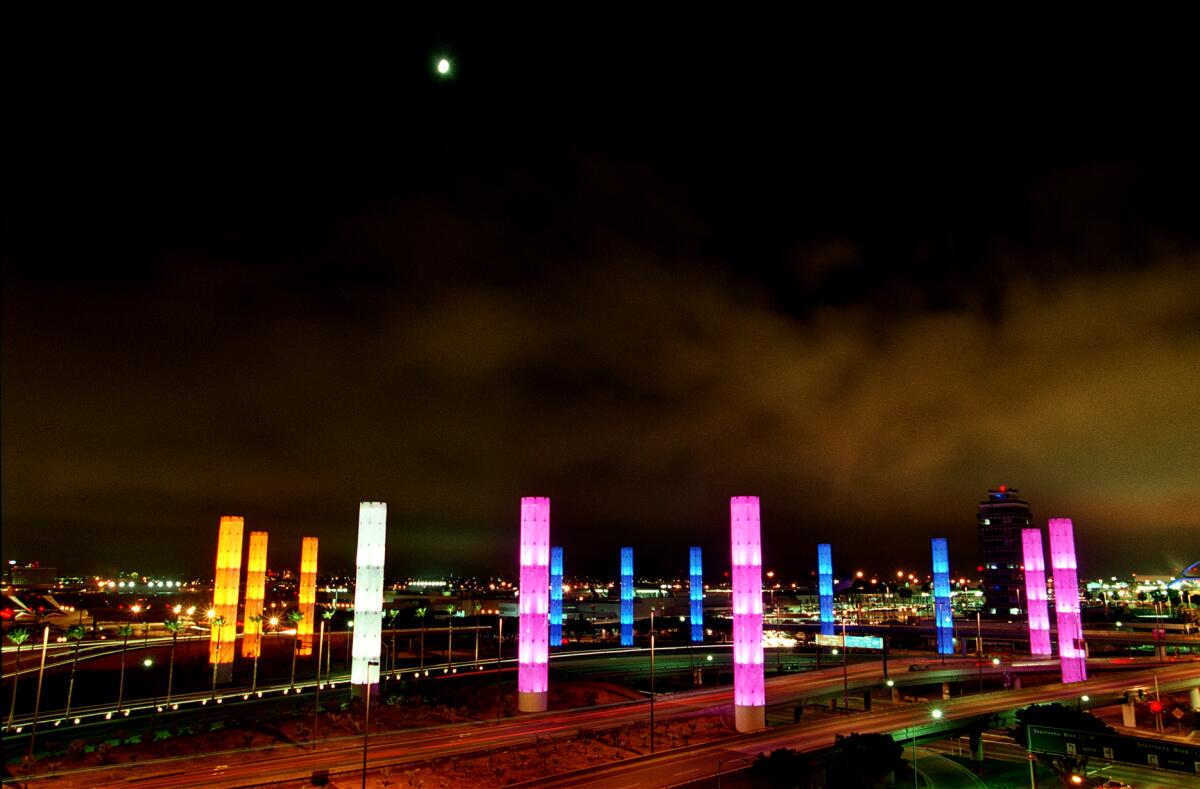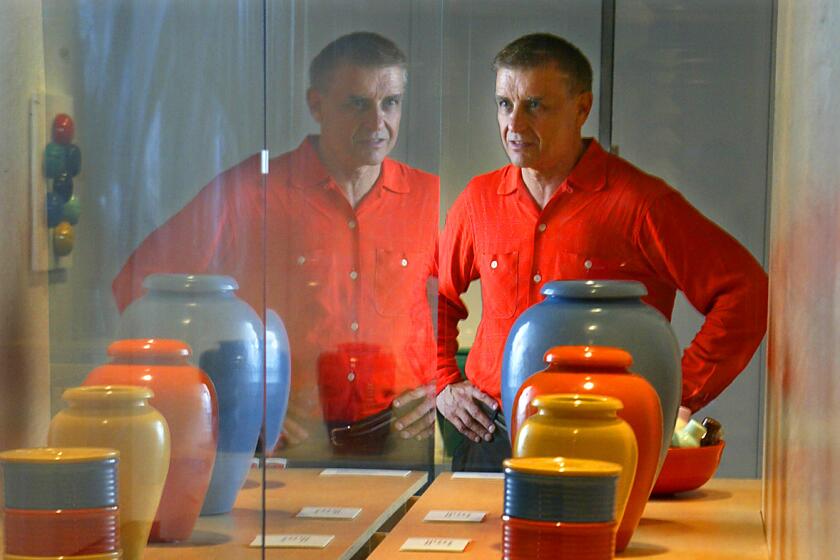Merry Norris, a founder of MOCA and patron of Los Angeles arts, is dead at 80
When Los Angeles Mayor Tom Bradley approached Merry Norris about joining the city’s Cultural Affairs Commission in 1984, she later told an interviewer, “I wasn’t sure what that was, but it sounded like a nice honor.”
It was an honor that Norris could have used to burnish her art patron credentials: attend a few meetings, rubber-stamp a rack of civic design projects around L.A., then talk about all the good she was doing at cocktail parties and in fancy magazines.
Instead, when she became president of the commission, two years later, she reworked its purpose and gave the organization teeth. As a Times story reported in 1992: “The commission, which has final design authority over all projects on or over city property, long had a reputation for passivity. Norris transformed the group into an activist board that raised the standards for design.”
Norris, a well-dressed powerhouse in a petite frame — she was all of 5 feet 2 — was not the sort to be taken lightly when it came to the aesthetics of Los Angeles.
Of designs issued by the Department of Water and Power for a series of new generating stations, she once told The Times: “In the past the DWP often showed us buildings that were, quite frankly, hokey. ... They were so dishonest in character — generating stations masquerading as country clubs, for instance — that we had to reject them out of hand.”
This did little for her profile among L.A.’s powerful real estate interests.
“We ran into a lot of resistance from developers and the city,” Norris once told The Times. “The city thought we were holding up projects. The mayor’s office put a lot of pressure on us.”
Pressures that left her unfazed — whether it was working on DWP infrastructure in the San Fernando Valley or an architectural extension for downtown’s Central Library.
“We build this city building by building,” she told The Times in 1988. “Each building is important ... to our thrust to improve the quality of life.”
Norris, a public servant and art consultant who helped reshape the artistic and architectural landscape of Los Angeles in her role on the city’s Cultural Affairs Commission and was a key founder of the Museum of Contemporary Art, died Monday night at Cedars-Sinai Medical Center. The cause was pneumonia unrelated to the coronavirus (she tested negative for COVID-19). The death was confirmed by her eldest daughter, Jill Govan Bauman.
She was 80 years old.

“Merry was one of the few people in Los Angeles who was really dedicated to supporting culture and the arts in all of its forms — including architecture,” said architect Thom Mayne, a founder of the L.A. firm Morphosis. “She was in love with the arts and the people who created it. She was devoted to supporting it in a difficult city.”
Mayne first met Norris in the mid 1980s, when they worked together on the Cedars-Sinai Comprehensive Cancer Center, completed in 1988. Morphosis did the architectural design; Norris worked as the project’s art consultant — integrating pieces by artists such as Robert Irwin, John Baldessari and Jennifer Steinkamp into the design.
It was a working relationship that quickly became a close family friendship. (Norris’ younger daughter, Joni Martino, now serves as Morphosis’ head of finance.) Before the project was even over, Mayne invited Norris to sit on the board of the Southern California Institute of Architecture (SCI-Arc), the experimental architectural school he had helped found in the early 1970s.
Mayne says that Norris was a vital, behind-the-scenes supporter of SCI-Arc, which has since become an internationally renowned architectural academy. “She was not a person who was all talk or concept,” he said. “She did what she said she was going to do” — which included helping raise millions for the school.
“Her generosity and passion for SCI-Arc and the arts was unparalleled,” said current SCI-Arc director Hernán Díaz Alonso in a statement. “Over the years, her contributions have made her inseparable from what SCI-Arc is and will continue to be. We will miss her deeply.”
It was her unsung involvement in the establishment of MOCA, however, that helped catapult Los Angeles into the ranks of contemporary arts centers.
She joined the effort in its infancy, in 1979, through her then-husband, the late William Norris, a lawyer and appellate judge who was then serving as the museum’s first board president.
“There are a lot of people involved when an institution like MOCA gets formed,” said Richard Koshalek, who served as the museum’s director from 1980 to 1999. “It involves a community, each making uncompromising commitments to this project. And she was an important part of that.”
Norris, who took on the role of acting director of development while the museum’s Grand Avenue building was under construction in the early 1980s — at a point in which the museum had all of four works in its collection — was essential to raising the museum’s founding endowment.
“She was extremely well connected and respected,” Koshalek said. “That made a huge difference. She believed that MOCA was important to the evolution of the arts in Los Angeles.”
And she did it not through strong-arming or intimidation, but through an easygoing charisma that has been widely celebrated on social media in the days since her death.
“She was the life of the party,” said Carlo Caccavale, executive director of the Los Angeles chapter of the American Institute of Architects, which made Norris an honorary member in 1990. “She was a tiny lady, but you could always see where she was by the amount of people clustered around her. She was always at the center.”
And she was always instantly identifiable in arts events around Los Angeles for her fashionable ensembles and the shock of white hair she kept in a chic, asymmetrical bob.
Bauman, her daughter, describes a woman who played piano, loved to dance and knew how to throw a great cocktail party — “the coolest, hippest person you knew.” But who was also in possession of a steely determination that she skillfully deployed in rooms that were often filled with powerful men.
“Her advice to me in all of this was, ‘Don’t learn how to type,’” Bauman recalled. “She told me, ‘Go be the head. Be in charge.”
Norris was born Merry Wright on Feb. 26, 1940, in Rochester, N.Y. Her father was a Canadian entrepreneur who helped launch an early radio manufacturer in Canada, while her mother came from a well-to-do Rochester family that had been connected, early on, with the Eastman Kodak Company. The family relocated to California when Merry was a teenager, settling in the Pasadena area.
For her undergraduate studies, Norris moved to the Bay Area to study at UC Berkeley. There, she met Gerald Govan, a student at Stanford University. The pair married in 1960 and Norris left school to start a family, giving birth to Jill. This brought her back to Los Angeles. But the marriage was short-lived, ending two years later.
In 1964, she remarried, to businessman John Wiester, with whom she had two more children: her son, James Wiester, and her youngest daughter, Joni. During this time, the family relocated to the Santa Barbara area.
And it was there that Norris began to hone her interest in art and design, serving as a patron and docent at the Santa Barbara Museum of Art. It was also during that period that she began to collect — often supporting artists just as they were beginning to emerge.
“She had phenomenal taste,” Bauman said. A 2017 profile of Norris in Curbed Los Angeles describes a home filled with works by artists such as Ed Ruscha, Mark Bradford and Jenny Holzer, as well as prototype chairs by architect Frank Gehry.
The founder of the Museum of California Design organized shows related to women in design and California pottery.
By the early 1970s, her marriage to Wiester had come to an end. But she soon became involved with William “Bill” Norris, who was then running for state attorney general in California (a race he lost). They married in 1974, relocating to Los Angeles the following year, and both fueled each other’s interests in art and politics.
Bauman describes the family home in Hancock Park as “a center” of politics. “There were dinners and hangouts and brainstorms,” she says. “Pat Brown and Jerry Brown and Tom Bradley, they were all there.”
And of course, there was also art — which they collected and supported in myriad ways. When Bill took the role of president of the nascent MOCA’s board, Merry joined in to help raise funds for the endowment. And her commitment didn’t end there.
Bennett Simpson, a longtime MOCA curator, describes a patron who was always engaged — not just with the high-profile events but with the art itself.
“She would turn up at routine curator walk-throughs of the permanent collection on a Thursday night,” he says. “She was there because she loved art and wanted to see what was happening in this place that was important to her.”
Her marriage to Bill (who died in 2017) ended after about a decade, but her interest in L.A.’s cultural life didn’t wane with the split.
She remained active on the Cultural Affairs Commission for half a dozen years until 1990. Among the important projects she helped shape was the expansion of Bertram Goodhue’s 1920s Central Library, located in downtown Los Angeles.
The expansion proposal, created by New York architect Norman Pfeiffer, originally included a tall, peaked atrium. The commission argued that the scale of Pfeiffer’s design would overshadow Goodhue’s graceful Art Deco building. After a political struggle that lasted for months, Pfeiffer came back with a flatter atrium structure that shaved off 12 feet of height.
“The point of it is, it started with a vital urban landmark,” Norris told the Times in 1988. “Now I think it’s truly supportive to the original building without mimicking it.”
Cobb died this week at 93. His U.S. Bank Tower, formerly the Library Tower, upgraded Los Angeles’ previously dull downtown skyline.
In addition to her various board positions, Norris was part of the Task Force on the Arts that helped establish a “percent for art” program in Los Angeles. And she remained active, throughout her life, as an art consultant, helping shape private and public projects around the city. This included the Gateway LAX project, which transformed the previously dour entrance to the airport with an installation of 32-foot letters reading “LAX,” as well as a sprawling artwork by Paul Tzanetopoulos that staggered nearly a dozen 100-foot pylons of light that change colors after dark.
Norris didn’t commission that work. (That responsibility fell to someone else.) But Tzanetopoulos said that Norris, who worked with the neighborhood’s business improvement district, was “the one making sure the project stayed on track politically and in the community.”
And she was “helpful in reminding people that this was an art commission — not a random light show,” he added. “She kept the public art component of the LAX project at the forefront.”

When Norris died at Cedars-Sinai, it was in a room overlooking the cancer wing she had a role in shaping — one that aimed to create a humane environment for patients going through debilitating cancer treatment.
“That’s what Merry was about,” Bauman said. “The intersection of art and architecture.”
Norris is survived by her three children and six grandchildren, as well as her sister Jonatha Dorman, who lives in London, and her half-sister Barbara Crane, who is based in New Jersey.
Because of the pandemic, a memorial will be announced at a later date. In the interim, the family is suggesting donations to the Merry Norris Scholarship Fund at SCI-Arc or the Merry Norris Creativity Fund at ImagineLA, a nonprofit that helps families on the verge of homelessness.
More to Read
The biggest entertainment stories
Get our big stories about Hollywood, film, television, music, arts, culture and more right in your inbox as soon as they publish.
You may occasionally receive promotional content from the Los Angeles Times.









